"Come for the tool, stay for the network." So said a16z partner Chris Dixon over a decade ago. However, the concept remains entirely true: the most successful apps today aren't just functional tools; they're ecosystems where users connect, collaborate, and create value for one another.
Think about it. Strava isn't just a fitness tracker; it's where athletes cheer each other on. Nextdoor isn't just a neighborhood app; it's where communities connect, share, and support one another. Patreon isn't just a media hub; it's where creators and fans build lasting relationships through exclusive content and direct support.
The difference between an app users occasionally open and one they can't live without? Community.
Yet despite overwhelming evidence that in-app communities drive retention, reduce churn, and increase lifetime value, many product managers still treat community features as a "nice to have", relegated to the bottom of the roadmap. This is a costly mistake. The apps that will thrive in 2025 and beyond are those that transform their users from isolated individuals into connected, engaged, and invested community members.
This guide will show you exactly how to do that.
What is an In-App Community?
An app's community is a social ecosystem built directly into a product where users interact, collaborate, and create shared value without leaving the app. Unlike traditional features that focus on individual user experiences, in-app communities transform products into interconnected spaces where user engagement becomes inherently social and mutually reinforcing.
At its core, an app's community consists of three fundamental elements:
- Native Integration: Community features are woven into the product's core functionality, not bolted on as an afterthought. When Peloton riders give high-fives during a workout or Notion users share templates within the workspace, they're engaging with community features that feel inseparable from the product itself.
- Persistent Identity: Users maintain consistent profiles and reputations across all community interactions. This persistence creates accountability, enables relationship building, and allows for the accumulation of social capital within the app ecosystem.
- Value Exchange Mechanisms: Whether through user-generated content, peer support, collaborative features, or competitive elements, in-app communities facilitate continuous value exchange between members. This might manifest as GitHub developers contributing to repositories, Zwift cyclists drafting off each other in virtual races, or Spotify users sharing playlists.
Key App Community Concepts
Understanding the fundamental principles that drive community behavior is crucial before implementing features. These concepts shape how users interact, form relationships, and create value within your platform, influencing every product decision you'll make.
Network Effects vs. Community Effects: While network effects increase a product's value as more users join (think messaging apps), community effects create value through the quality and depth of user interactions. A million silent users create network effects; a thousand engaged community members create community effects that often prove more valuable.
The Engagement Pyramid: Not all community members participate equally. Typically, 1% are creators, 9% are contributors, and 90% are consumers. Thriving in-app communities design for all three tiers, providing pathways for users to move up the pyramid while ensuring value for those who prefer to observe.
Community Surface Area: This refers to the number and variety of touchpoints where users can interact within your app. Greater surface area—through features like comments, reactions, direct messaging, forums, or collaborative spaces—increases the likelihood of meaningful connections forming.
Social Graph Architecture: How your app structures relationships matters. Are connections bidirectional (mutual friends) or unidirectional (followers)? Are they interest-based (topics/groups) or activity-based (shared experiences)? These architectural decisions fundamentally shape community dynamics.
In-App Communities vs. External Communities
The distinction between in-app vs. external communities isn't merely about location; it's about integration, control, and user experience.
External communities (Discord servers, Reddit communities, Facebook groups) exist on third-party platforms. While they can be vibrant and valuable, they suffer from critical limitations:
- Fragmented Experience: Users must context-switch between platforms, breaking flow and reducing engagement
- Limited Data Access: Product teams can't directly measure or optimize community interactions
- No Feature Integration: Community activities can't trigger in-app events or unlock features
- Platform Risk: Terms of service changes or platform pivots can destroy communities overnight
- Diluted Brand Experience: Your community exists within another company's design language and constraints
App communities, by contrast, offer distinct advantages:
- Seamless Integration: Community interactions happen within the natural flow of product usage
- Rich Data Insights: Every interaction provides actionable data for product improvement
- Feature Synergy: Community activities can unlock features, grant permissions, or trigger workflows
- Complete Control: You own the platform, the data, and the relationship with your users
- Unified Experience: Community features share your product's design system and user experience
Consider how Nextdoor's community features are inseparable from its content experience, or how Figma's commenting system is embedded directly into the design canvas. These aren't communities attached to products—they're products built around communities.
The most successful in-app communities don't require users to go elsewhere to connect. They make connection an inevitable, delightful part of using the product itself.
Benefits of Communities for Your Product
Too often, in-app communities get reduced to a checklist ofsocial features. But when done right, they reshape how users interact with your product and each other. Here are the concrete benefits that make community features a strategic imperative for product managers.
Increase User Retention and Engagement Metrics
The most immediate impact of an app's community shows up in your retention curves. When users form connections within your app, they create their own reasons to return, beyond your core functionality.
The Retention Multiplier Effect
Communities create multiple touchpoints for engagement:
- Users return to check responses to their posts
- They come back to see what's new in discussions they follow
- They feel obligated to maintain streaks or relationships they've built
- They develop FOMO when not participating in community events
This transforms your app from a tool used when needed into a destination users habitually visit. The community becomes a living, breathing entity that's different every time users open your app, creating natural re-engagement loops.
Example: Peloton - Users return daily not just to exercise but to high-five friends, check leaderboard rankings, and join group rides with their favorite instructors.
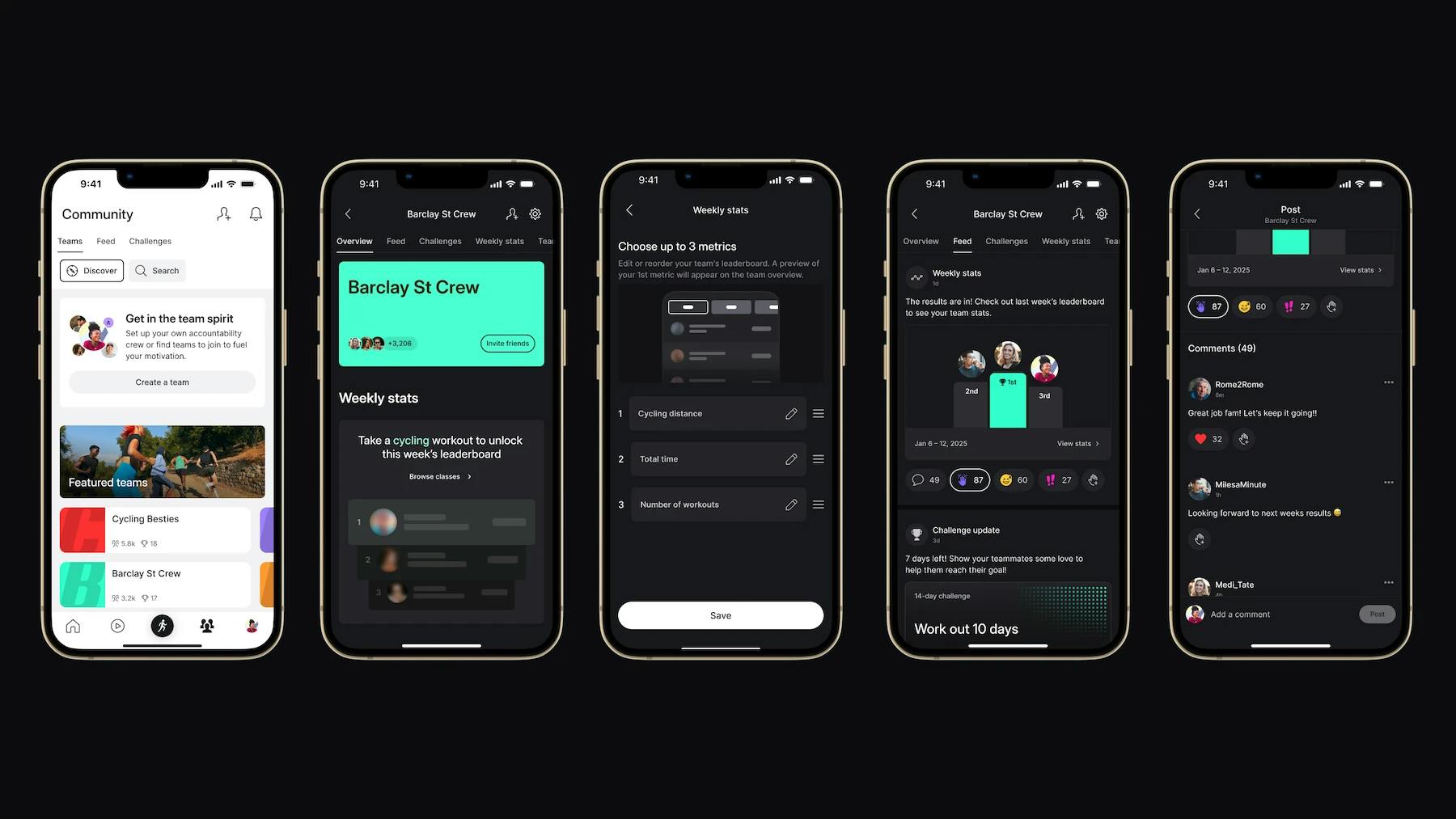
Engagement Depth vs. Surface-Level Usage
Without community features, user engagement is transactional: open app → complete task → leave. With community, engagement becomes multi-dimensional:
- Users spend time browsing community content after completing core tasks
- They contribute content that brings them back to see responses
- They develop routines around community participation
- They discover new use cases through peer interactions
The shift from single-player to multiplayer experiences naturally increases session duration, session frequency, and overall time spent in-app.
Example: Strava - Athletes who join to track runs end up browsing others' activities, giving kudos, and joining challenges.
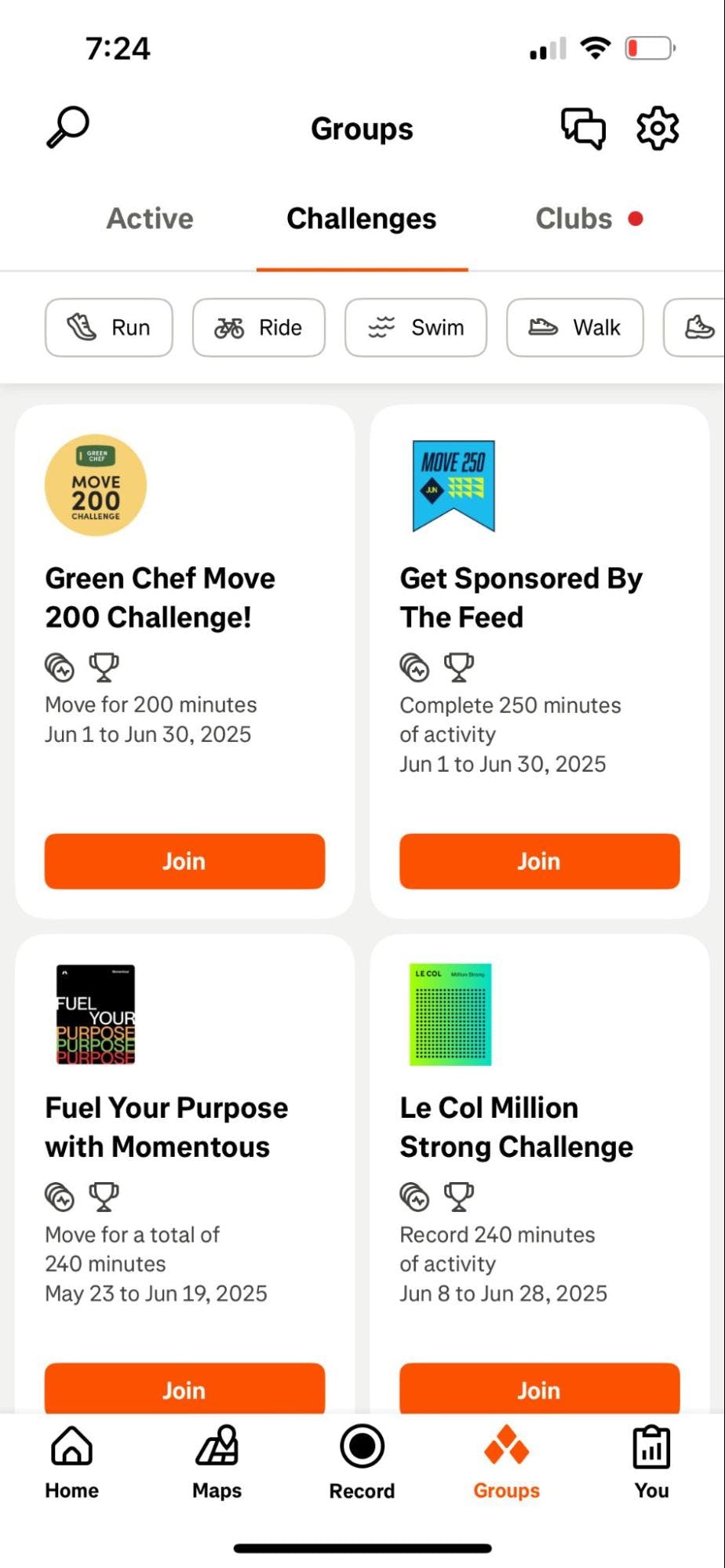
Reduce Customer Support Costs
One of the most tangible ROI benefits of in-app communities is the dramatic reduction in support costs through peer-to-peer assistance.
The Economics of Community Support
Traditional support models require linear scaling—more users mean more support agents. Community support scales exponentially—more users mean more potential helpers. This fundamental shift in economics makes community support increasingly valuable as you grow.
Consider these dynamics:
- Experienced users naturally help newcomers
- Common questions get answered once and referenced many times
- Users often explain solutions in more relatable terms than official documentation
- 24/7 peer support coverage across time zones
- Reduced ticket volume frees agents to handle complex issues
Example: Notion - Power users create templates and guides that answer questions before new users need to ask support.
Building a Knowledge Repository
Unlike support tickets that solve problems in isolation, community discussions create a searchable knowledge base:
- Solutions become discoverable through search
- Users can see how others solved similar problems
- Community-validated answers carry social proof
- Documentation gaps become visible through repeated questions
Example: Apple Support Communities - User solutions for iOS issues become searchable answers that help millions troubleshoot problems without contacting support.
Drive User-Generated Content (UGC)
User-generated content transforms your app from a product you maintain into a platform your users build together.
The Content Flywheel
Communities create a self-reinforcing content cycle:
- Early users share experiences and insights
- Their content attracts new users searching for information
- New users contribute their own perspectives
- Content variety attracts even more diverse users
- The cycle accelerates as the community grows
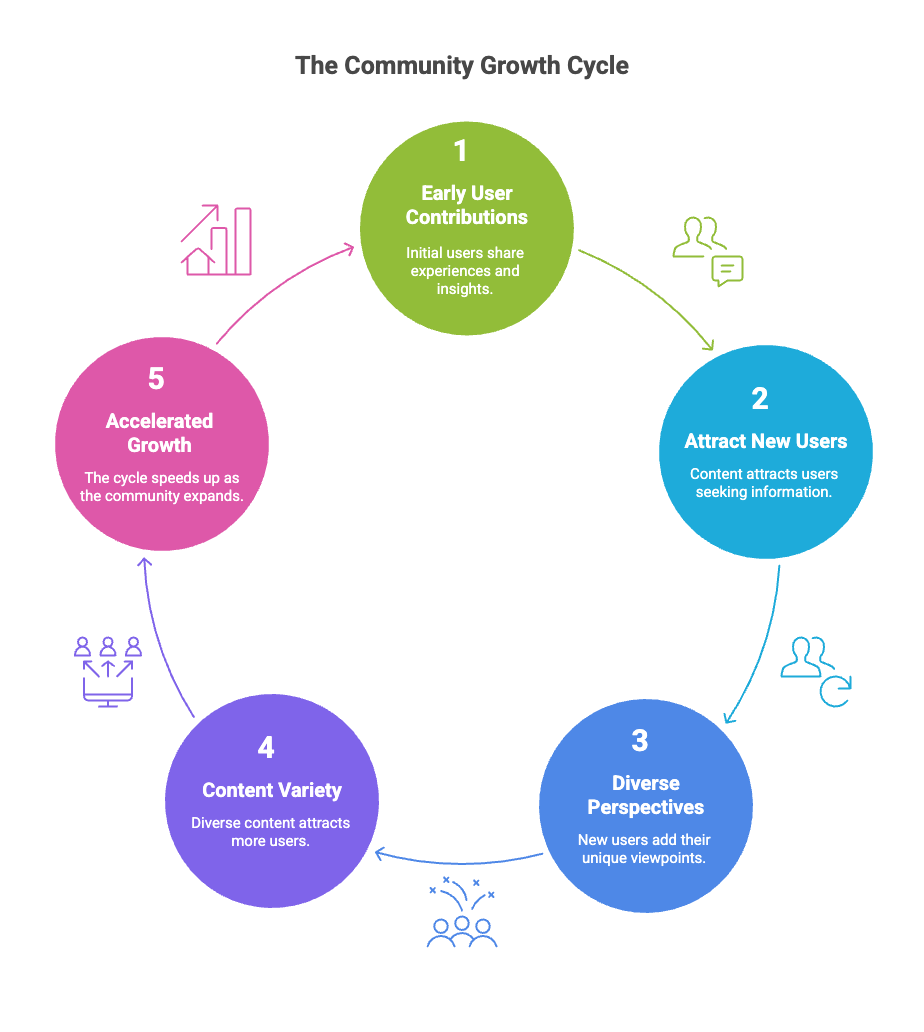
Example: Pinterest - Users curating boards attract others searching for inspiration, who then create their own boards.
Types of Valuable UGC in Communities
- Tutorials and How-Tos: Users explain features in their own words, often covering use cases you never imagined
- Templates and Resources: Members share worksheets, configurations, and tools they've created
- Success Stories: Real user outcomes provide social proof more powerful than any marketing
- Feature Ideas: Community discussions surface product improvements directly from user needs
- Troubleshooting Guides: Users document workarounds and solutions for edge cases
This content does more than fill your app. It makes it more valuable for every user, creating compound benefits over time.
Example: Figma Community - Designers share UI kits and design systems that others can duplicate and build upon.

Build Brand Loyalty and Advocacy
Communities transform satisfied users into passionate advocates who actively promote and defend your product.
From Users to Champions
Community participation creates emotional investment through:
- Identity Formation: Users become known for their expertise or contributions
- Relationship Building: Friendships formed in your app create switching costs
- Ownership Mentality: Contributors feel partially responsible for the community's success
- Status and Recognition: Community achievements provide intrinsic rewards
Example: Peloton - Members form identities around favorite instructors and achievements, making subscriptions feel essential.
The Advocacy Amplification Effect
Engaged community members become your most potent marketing channel:
- They organically mention your app in external conversations
- They defend your product against competitors in public forums
- They create external content (blogs, videos, social posts) about their experiences
- They actively recruit friends and colleagues to join
- They provide testimonials and case studies willingly
This organic advocacy carries more weight than any paid marketing because it comes from genuine user enthusiasm.
Example: Obsidian - Plugin developers showcase their creations on YouTube and Reddit, driving organic user acquisition.
Lower User Acquisition Costs (CAC)
While community features require upfront investment, they systematically reduce acquisition costs through multiple mechanisms.
Viral Loops and Network Effects
Communities create natural viral mechanics:
- Users invite others to collaborate on community projects
- Shared content brings in users through search and social shares
- Community events and challenges encourage friend invitations
- Public leaderboards and achievements drive social sharing
- User-generated content ranks in search engines, driving organic traffic
Example: Minecraft - Players invite friends to join their servers and realms, creating chains of recruitment as each new player builds and wants to show others.
Improved Conversion Through Social Proof
Prospective users who discover active communities convert at higher rates:
- They can see real users getting value from your product
- Community content addresses their specific concerns
- They can ask questions before committing
- Success stories from similar users reduce perceived risk
- The community itself becomes a compelling reason to join
Example: Webflow - The Made in Webflow showcase lets prospects see real sites built by peers, converting browsers to subscribers.
Essential Features for In-App Communities
Building a thriving community requires more than just adding social features. The most successful platforms share essential capabilities that transform isolated users into active, engaged community members.
Real-Time Messaging and Communication
At the heart of every community lies conversation. But modern communities demand sophisticated in-app messaging that goes far beyond basic chat.
Key capabilities that drive engagement:
- Threaded conversations: Keep discussions organized and searchable. Figma's comment threads on specific design elements prevent important feedback from getting lost in the main chat flow.
- Rich reactions: Enable lightweight engagement without notification spam. A simple 👍 can acknowledge a message instantly.
- Smart @mentions: Create attention hierarchies:
- @channel for urgent team-wide updates
- @here for currently active users
- Individual mentions for direct attention
Technical considerations: Message persistence requires balancing storage costs with search functionality. Implement efficient indexing for instant search across millions of messages. Consider reaction data structures that handle thousands of emojis per message without impacting load times.
Activity Feeds and Content Discovery
Fresh content keeps communities alive. Smart feeds ensure users discover relevant updates without drowning in noise.
Feed intelligence features:
- Aggregation: "3 people liked your post" instead of three separate notifications
- Multi-algorithm options: Let users choose between "Top" and "Recent"
- Content diversity: Mix posts, photos, achievements, and activities

GitHub's activity feed demonstrates this perfectly—it aggregates similar events while maintaining the satisfaction of seeing multiple stars on your repository.
Technical considerations: Implement event batching systems that group activities by type and time window. Use predictive pre-loading for smooth infinite scroll. Cache aggressively but invalidate intelligently.
Moderation and Safety Tools
Trust is non-negotiable. Layer human and AI content moderation to create safe spaces.
The moderation stack:
- AI pre-moderation: Block harmful content in <50ms
- Community moderation: Downvotes, reports, and peer review
- Graduated responses: Warnings → Mutes → Timeouts → Bans
- Context awareness: Different rules for different sub-communities
Reddit's karma system shows how community self-moderation can scale. Users police content quality through voting, while moderators handle serious violations.
Technical considerations: Build flexible rule engines that can adapt to different community standards. What's acceptable in a gaming community might be inappropriate in a professional network.
User Profiles and Identity
When done right, profiles become more than names and avatars. They build reputation and relationships. Progressive profile building involves:
- Start simple (name + avatar)
- Unlock features with completion
- Showcase achievements naturally
- Maintain privacy controls
Stack Overflow's reputation system instantly communicates expertise. A user with 50k reputation has proven knowledge. This social proof drives quality contributions and creates healthy hierarchies.
Technical considerations: Aggregate activity data efficiently. Cache aggressively for power users with extensive histories. Design reputation algorithms that resist gaming.
Engagement and Gamification
Make participation inherently rewarding. Proven mechanics include:
- Streaks: Snapchat's Snapstreaks create daily habits through loss aversion
- Achievements: Xbox achievements guide behavior and reward exploration
- Leaderboards: Segment by demographics for achievable competition
- Points systems: Reward diverse behaviors, not just posting
Peloton segments leaderboards by age and equipment type, ensuring everyone finds relevant competition. This inclusive design keeps all users engaged, not just the top performers.
Technical considerations: Handle time zones correctly for streaks. Nothing frustrates users more than losing a 365-day streak to a timezone bug.
Live and Synchronous Experiences
Real-time shared experiences create the strongest bonds. Live engagement tools include:
- Low-latency streaming (<3-second delay)
- Interactive overlays (polls, Q&A, reactions)
- Voice channels for persistent hangouts
- Synchronized activities (watch parties)
Discord's voice channels show active speakers, creating FOMO that draws users into conversations. This persistent presence indicator transforms empty rooms into lively spaces.
Technical considerations: WebRTC for voice/video, adaptive bitrate streaming, geographic server distribution. Plan for 10x traffic spikes during popular events.
Groups and Sub-Communities
Communities naturally segment as they grow. Group management essentials include:
- Flexible privacy levels
- Public (discoverable by all)
- Private (invite-only)
- Secret (hidden completely)
- Delegated moderation
- Admin hierarchies
- Custom mod permissions
- Audit trails
- Cross-pollination features
- Content sharing between groups
- Discovery algorithms
- Related group suggestions
WhatsApp's group admin features demonstrate effective delegation—admins can restrict posting, approve members, and delegate permissions without overwhelming complexity.
Technical considerations: Implement efficient permission inheritance systems that cascade from parent groups to subgroups without requiring recursive database queries.
Notifications and Re-engagement
Smart notifications maintain engagement without creating fatigue. Intelligent notification features include:
- Bundling: Group related activities
- Prioritization: Direct mentions > Comments > Likes
- Scheduling: Respect do-not-disturb hours
- Multi-channel: Push, email, in-app coordination
Duolingo's streak freeze notifications arrive just before a streak would break. This predictive timing creates urgency without annoyance.
Technical considerations: Build preference systems that sync across devices instantly. Queue non-urgent notifications for optimal delivery times.
Integration and Interoperability
Communities exist across platforms. Enable seamless connections. Integration priorities include:
- Webhooks: Real-time event streaming
- APIs: Well-documented, versioned, rate-limited
- SSO: Reduce login friction with OAuth providers
- Data portability: Respect user ownership with export tools
When someone posts in Discord, webhooks can trigger GitHub actions or update Notion databases. This interconnectedness makes communities more valuable than isolated platforms.
Technical considerations: Implement robust webhook retry logic with exponential backoff to handle third-party service failures. Design API rate limiting that's fair to power users while preventing abuse, using sliding windows and token buckets for different endpoint types.
The key to successful in-app communities is choosing the right features for your community's purpose and values. Start with core communication and safety features. Layer on engagement and discovery tools based on observed user behavior.
Most importantly, maintain the technical flexibility to evolve as your community grows and changes.
In-App Community Moderation Best Practices
Moderation enables healthy community growth. The most successful communities invest in moderation infrastructure early, before problems arise, creating environments where positive interactions flourish naturally.
Setting Up Moderation Workflows
Begin with clear, escalating workflows that strike a balance between automation and human judgment. The most effective content moderation systems use a tiered approach:
- Pre-moderation layer: AI screens content before it goes live, catching apparent violations in milliseconds. This prevents harmful content from ever reaching your community.
- Community flagging: Empower users to report concerns quickly. Design one-click reporting with categorized reasons (spam, harassment, misinformation) to streamline review queues.
- Moderator review queues: Create specialized queues for different content types—text, images, and video require different review interfaces. Prioritize by severity and user history.
- Escalation paths: Not every decision is clear-cut. Build escalation routes from community moderators to senior mods to staff, with clear handoff protocols.
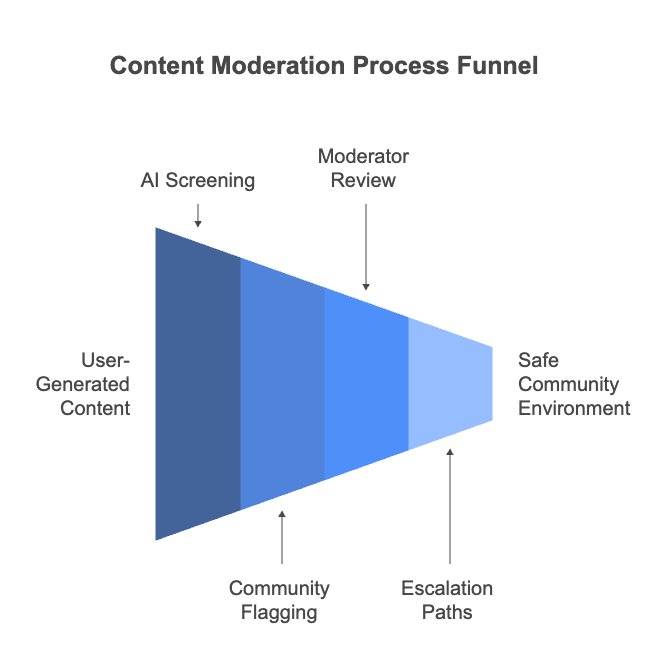
The key is to make moderation feel seamless to users while providing moderators with powerful tools. Keyboard shortcuts, bulk actions, and contextual user history turn moderation from a chore into an efficient process.
AI-Powered Content Filtering
Modern AI makes proactive moderation scalable and affordable. Instead of playing whack-a-mole with policy violations, implement intelligent systems that learn from your community's standards.

Multi-modal detection capabilities include:
- Text analysis for hate speech, harassment, and spam across 45+ languages
- Image recognition for explicit content, violence, and custom violations
- Video frame analysis and audio transcription for comprehensive coverage
- Username and profile screening at registration
Configurable confidence thresholds let you tune the balance between safety and false positives. Set stricter thresholds for new users while giving established members more leeway.
Semantic understanding goes beyond keyword matching. Modern AI understands context, distinguishing between educational discussions about sensitive topics and actual policy violations. This reduces frustrating false positives that drive away good users.
Custom training adapts AI to your specific community. Feed it examples of edge cases unique to your domain. A medical community needs different standards than a gaming platform.
Training Community Moderators
Your most engaged users often make the best moderators—they understand community culture and have earned peer respect. But passion alone isn't enough.
Structured onboarding programs typically:
- Start with clear documentation of community values and policies
- Use real example cases showing correct decisions and reasoning
- Implement shadow moderation where trainees review already-decided cases
- Graduate to supervised moderation with mentor oversight
- Provide ongoing training as policies evolve
Moderator tools that reduce burnout include:
- Rotation schedules prevent any one person from seeing too much negative content
- Mental health resources and regular check-ins
- Clear boundaries about moderator responsibilities
- Recognition systems celebrating good moderation decisions
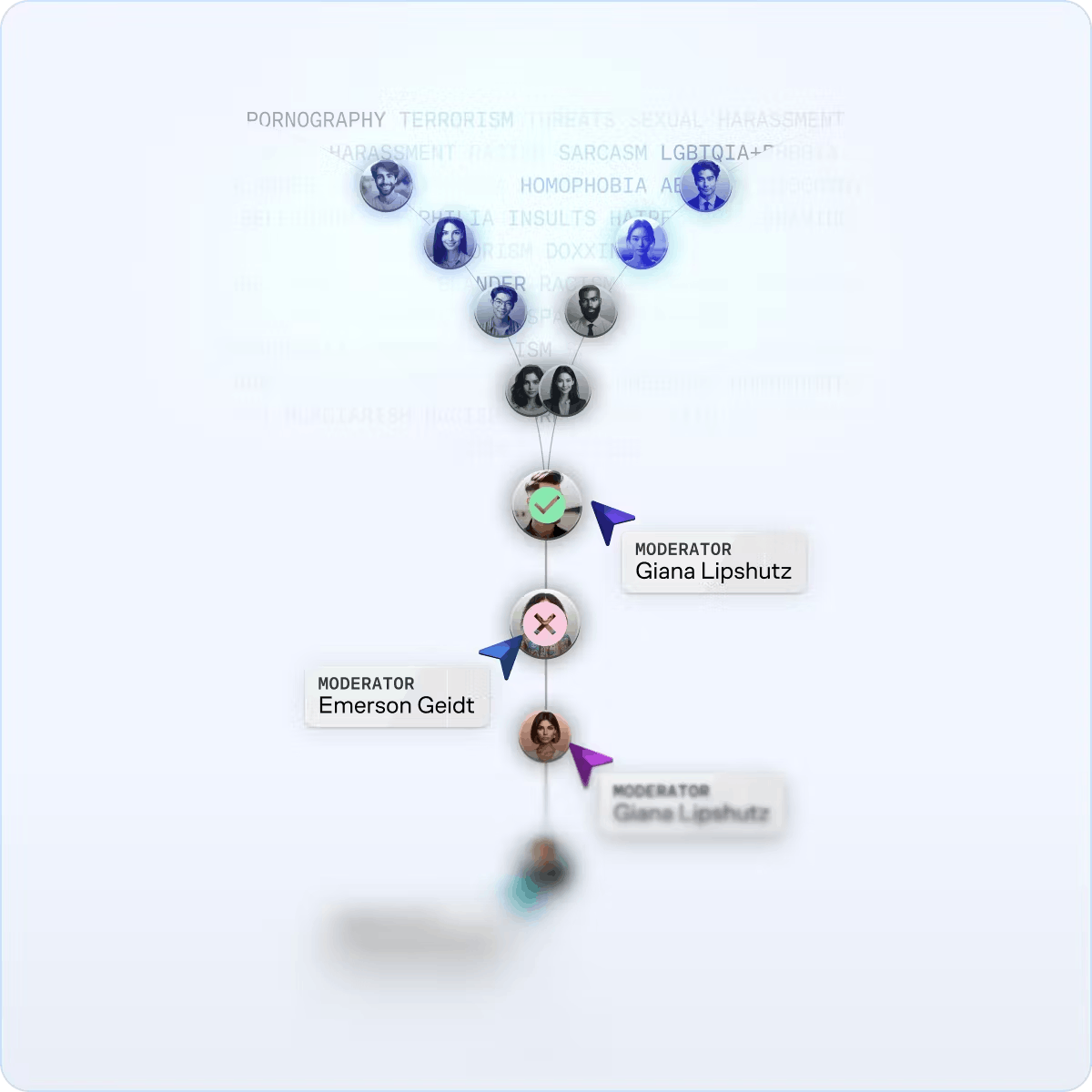
Decision consistency frameworks: Create decision trees for common scenarios. When moderators have clear guidelines, they make faster, more consistent decisions that users perceive as fair.
Handling Conflicts and Toxic Behavior
Prevention beats cure, but conflicts will arise. Design systems that de-escalate tensions before they poison community culture.
Graduated response systems include:
- Warnings: Private messages explaining policy violations
- Temporary mutes: Cool-off periods preventing heated exchanges
- Restricted privileges: Limiting features like image posting or group creation
- Shadow banning: Toxic users see their content, but no one else does
- Permanent bans: Reserved for severe or repeated violations
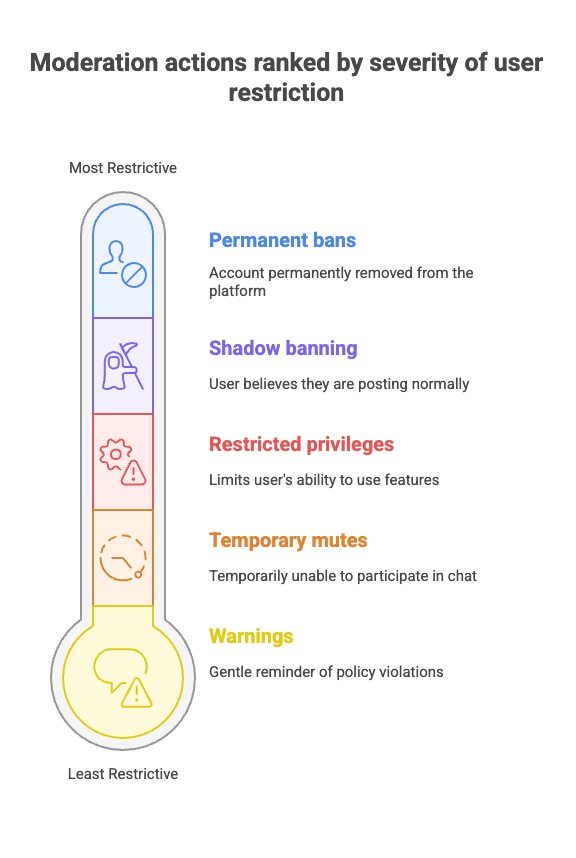
- Context preservation helps moderators make informed decisions. Show user history, previous warnings, and positive contributions alongside current violations. A longtime helpful member having a bad day deserves different treatment than a serial harasser.
- Appeals processes build trust. Clear paths for users to contest decisions show fairness. Time-bound reviews ensure appeals don't languish. Even when upholding original decisions, explaining the reasoning helps users understand boundaries.
- Behavioral nudges prevent conflicts before they start. Think gentle reminders when comments contain aggressive language, or cooling-off periods before posting heated replies. These microsecond interventions dramatically reduce moderation workload.
Legal Compliance and Safety
Moderation plays a critical role in not only community health but also legal obligations that vary by jurisdiction and grow more complex yearly.
Regulatory compliance essentials include:
- COPPA: Age verification and parental controls for users under 13
- GDPR: Data retention policies and user content deletion rights
- DSA: Transparency reports and appeal mechanisms for EU users
- Section 230: Understanding platform vs. publisher responsibilities
Every moderation action needs an audit trail. Who made the decision, when, why, and under which policy. These logs prove good-faith content moderation efforts and protect against liability. Build dashboards tracking moderation metrics required by regulations:
- Volume of content reviewed
- Response times to reports
- Appeal outcomes
- Categorized violation types

Have clear procedures for:
- Self-harm content requiring immediate intervention
- Credible threats requiring law enforcement contact
- CSAM discovery and reporting to NCMEC
- Coordinated harassment campaigns
- Platform manipulation attempts
Moderation shapes culture. Every decision about what content stays or goes teaches your community what behavior is valued. The communities that thrive long-term are those that invested in moderation infrastructure before they needed it.
By implementing AI-powered tools early, training moderators properly, and building escalation systems that balance automation with human judgment, you create spaces where positive interactions naturally outnumber negative ones.
Key Metrics to Track
Community features require significant investment, so demonstrating their impact is crucial for continued support and optimization. The key is connecting community metrics to business outcomes that executives care about.
Engagement Depth Metrics
These metrics reveal how deeply users interact with your community features, moving beyond simple login counts to understand meaningful participation. Track these to identify which features drive habitual use and where users find the most value.
- DAU/MAU Ratio: Communities should drive daily habit formation. A healthy community typically shows higher ratios than the core product alone.
- Community Participation Rate: What percentage of total users engage with community features? Track viewers, contributors, and creators separately.
- Content Creation Velocity: Posts, comments, and reactions per active user. Rising velocity indicates growing engagement.
- Response Time and Rate: How quickly do questions get answered? What percentage receive helpful responses?
Retention Indicators
Community engagement often predicts long-term retention better than product usage alone. These metrics help identify at-risk users early and understand which community features create the strongest user loyalty.
- Cohort Retention Curves: Compare users who engage with community vs. those who don't
- Feature Adoption Ladders: Track progression from lurker → commenter → poster → community leader
- Social Graph Density: Average connections per user and interaction frequency between connections
- Churn Prediction Scores: Users who stop community participation often churn from the product entirely
Community Health Signals
A thriving community self-regulates and generates positive value for all members. Monitor these signals to catch problems early and ensure your community remains a welcoming, valuable space as it scales.
- Sentiment Analysis: Track positive/negative/neutral content ratios over time
- Moderation Load: Violations per thousand posts indicate community self-governance
- User-Generated Content Quality: Upvote/downvote ratios, best answer selections, content sharing rates
- New User Success Rate: How many new members become active participants within 30 days?
Creating Executive Dashboards
Transform community metrics into business insights that drive executive decision-making. Focus on outcomes over activities, showing clear connections between community health and company KPIs.
- Business Outcome Focus: Lead with revenue impact, cost savings, and strategic goals
- Trend Visualization: Show directional changes and velocity, not just snapshots
- Segmentation Insights: Break down by user segments that matter (free/paid, new/tenured, geographic)
- Actionable Metrics: Every number should suggest clear next steps
- Executive-Ready KPIs: Community-attributed revenue, support cost savings, CAC reduction, competitive differentiation, and risk indicators
Community metrics are leading indicators of product health. Declining community engagement often predicts future churn. Rising participation indicates growing product-market fit.
By establishing comprehensive measurement frameworks early, you can optimize community features based on data rather than intuition, demonstrating clear ROI while building sustainable competitive advantages.
A Path to In-App Community Success
Building an in-app community is essential for creating products users can't live without. The apps that will dominate 2025 and beyond are those that transform isolated users into connected, engaged community members who drive retention, reduce support costs, and become passionate advocates.
Here's how to build in-app community:
1. Start with Core Communication
- Implement threaded messaging and smart @mentions
- Add basic user profiles with avatars and bio sections
- Build simple activity feeds showing user interactions
2. Establish Safety First
- Set up AI-powered content filtering for text and images
- Create clear community guidelines and reporting mechanisms
- Train initial moderators before launching to the public
3. Design for Discovery
- Build content recommendation algorithms for relevant posts
- Add search functionality across community discussions
- Implement user discovery through shared interests or activities
4. Layer on Engagement
- Add reactions, likes, and lightweight interaction methods
- Create achievement systems and progress indicators
- Build notification systems that drive re-engagement without spam
5. Measure and Iterate
- Track DAU/MAU ratios for community features vs. core product
- Monitor retention differences between community and non-community users
- Create executive dashboards showing community impact on business KPIs
Start small, launch early, and let your users guide the evolution. The most successful communities aren't built overnight; they're carefully nurtured into thriving ecosystems where users create value for each other.
